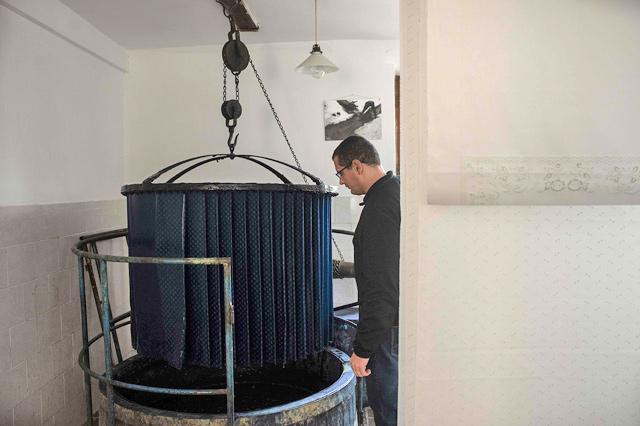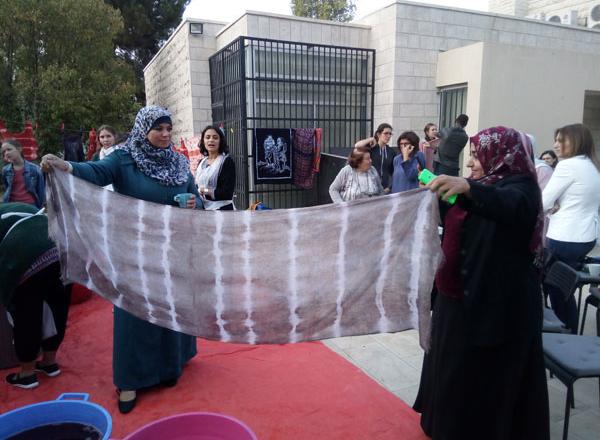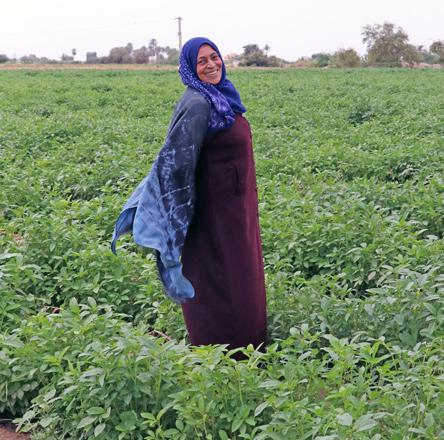You are here
To dye for: Czech blueprint tradition alive and well
By AFP - Jul 18,2020 - Last updated at Jul 18,2020

Czech craftsman Jiri Danzinger dippes a wax printed cotton textile in the tub of water dyed indigo blue at his blueprint workshop on March 10 in the eastern village of Olesnice town (AFP photo by Michal Cizek)
OLESNICE, Czech Republic — For Jiri Danzinger, settling on a line of work was a no-brainer: he grew up in a Czech family with a long tradition in blueprint dyeing.
The 40-year-old craftsman is the 11th generation of a family living off the UNESCO-listed technique in the eastern village of Olesnice.
“Nobody ever forced me, but I also never had another job offer,” the bespectacled Danzinger told AFP in one of the Czech Republic’s two surviving blueprint workshops, his hand resting on an age-old rolling press.
Blueprint, which made its way to Europe in the 17th century, uses so-called resist printing, which involves dipping a large wooden stamp — typically with a floral pattern — into a gum Arabic paste.
Artisans like Danzinger then apply the pattern to white cotton fabric before submerging it in a tub of water dyed indigo blue.
When he pulls out the fabric using a creaky handle, it is blue but the design remains white.
Clover and oat grass
UNESCO added blueprint dyeing to its Intangible Cultural Heritage list in 2018 following a joint bid by the Czech Republic and Austria, Germany, Hungary and Slovakia — where the technology has also survived.
“We live in a poorer region so we use simple motifs such as clover or oat grass,” said Danzinger, whose workshop has 250 different designs.
“Wealthier regions use fancier patterns,” he added before smoothing wrinkles from a fabric using a rattling rolling press.
Marketa Vinglerova, deputy head of the textile collection at Prague’s Museum of Decorative Arts, said blueprint came to Europe from Asia, notably the traditional indigo-dyeing countries of India, Indonesia and Japan.
Thanks to the Dutch East India Company, founded in the 17th century to trade with the Far East, blueprint made its way to the Dutch court and then to central Europe, including the Baltics and Poland.
“It was popular among aristocrats but then it spread to small towns and villages and the nobility abandoned it,” Vinglerova told AFP.
“For a long time, it was the only decorative technology the villagers could afford.”
Olesnice’s dyeing tradition dates back to 1520. Before indigo, dyers used woad leaves to turn scarves, bed covers and aprons blue.
Face masks
Danzinger’s workshop makes a range of products from stuffed toys to bags, handkerchiefs and ties.
During the coronavirus crisis, it switched to making face masks after the government made face coverings mandatory in public.
From one day to the next, “we were churning out face masks at full speed. We agreed it was necessary”, Danzinger said.
The workshop first produced white cotton masks to hand out to local residents, but later also supplied the police as the country faced a nationwide shortage of medical material.
“When we met the demand after two weeks, we started producing blueprint face masks. We sold more than 1,000 of those by the end of June,” Danzinger said.
In the renovated village house where he lives and works, Danzinger said he feels a lifelong “obligation” to continue what his ancestors started.
“People come and go but the craft will hopefully stay the same forever.”
Related Articles
Amman — The Ghor Al Safi Women’s Association, a group of women from the Jordan Valley producing dyed textiles in collaboration with Tiraz Ce
AMMAN — A project that utilises the colourful soil and natural plants of Jordan to produce hand-dyed textiles in the Jordan Valley is testam
AMMAN — As most dye used for our daily life products have become synthetic, natural dye from Indigofera tinctoria (also known as “true indig



















